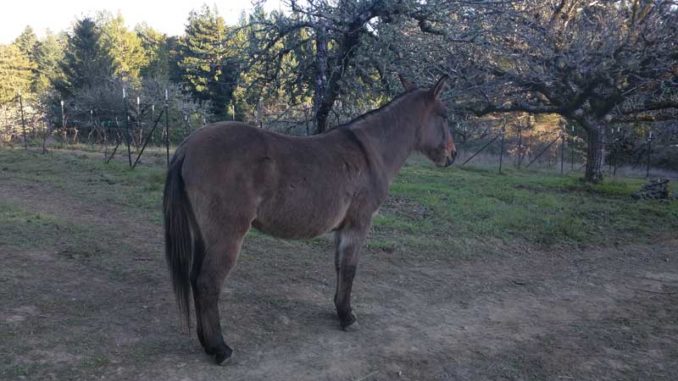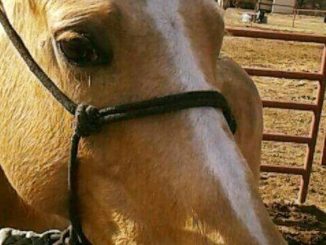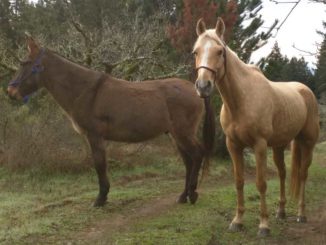Podcast: Play in new window | Download
Subscribe: RSS
Today we are going to talk about James French’s Trust Technique and how it brings up trauma to be released and resolved. Last week I talked about my horses and my path of finding a training method that would work for me and the animals. We continue today with a little more details about the animals and my experience applying the Trust Technique with them.
I talked a little about my training efforts during the first weeks I had the animals in episode 44 with a focus on the StarHealing the blonde mare. Rusty Moon the mule has a different personality. In general, he seems more playful, easy going and gregarious. However, he is a little neurotic too and was initially obsessed with standing on the top of the 500 foot driveway watching the road. He would go ballistic if he didn’t have access to his vantage spot.
This behavior worried me a great deal and I thought it might be connected to something in his past. I was told that he totally went crazy and kicked the trailer and mare during unloading of another horse three hours south of me. He had to be put into his own pen in the trailer to keep the other horses safe. The transport driver said he had been incredibly well behaved the whole trip and he thought the mule was in love with the other horse that was leaving and his reaction was based on that.
I was worried that I wasn’t the right place for him. Him being able to stay with his friend was important to me. To make matters worse, the mare was completely hostile towards him. She owned everything. She got first access to the food and me. If he was eating she would make him move. If I was grooming him she would come push him around. I wasn’t sure what to do. If I gave him attention she would bite at him when I left.

Here he was on my property watching the road and I wasn’t sure if he was waiting for a trailer to deliver his friend or perhaps he was hoping to go back to Texas and get away from the Mare. I wanted him to have the best living situation where he could be happy and being with the bitchy mare didn’t seem like much fun. I finally contacted the rescue to determine if he had left his heart in Texas. As it turned out he did have a good buddy at the rescue. They would play together in the field and eat together side by side. I was tempted to get his friend, but I wasn’t sure that was really the issue and his friend was being groomed for greater things.
I was assured by the rescue that he was just being protective of his territory. The animal whisperer told me the same thing. He told me it’s a mule’s job to protect the herd. I wasn’t so sure. Anyway, for better or worse, poor Rusty Moon was stuck with a grumpy mare. However, I had a sense that this dynamic would change as mare became less tense and more secure. She was deeply dissatisfied and irritable. My plan was to change that. I was beginning to sense that this was as much a part of the journey as anything. You see, on some level I am deeply dissatisfied and irritable myself.
My first challenge with the horse/mule dynamic was to stop reacting to her nastiness by judging her and getting angry at her. I had to let go of my sense of rightness. I wanted her to be nice and generous, instead she was asserting herself as the alpha mare. It was what it was and my job was to bring a nonreactive presence to the situation. This took a little practice, since my tendency was to get pissed off at what she was doing. Occasional visitors would label her as jealous of attention, but I resisted putting a label on her. Okay, I wasn’t quite successful at that. I would shake my head and call her a bitch, but the shake of my head was more to shake the judgment out of my head. I could curb any behavior that was in reaction to her being aggressive with the mule, however I often left the farm feeling sad.
This was my second challenge. How to be at peace with the unfairness of the situation. I had a sense that the mule could be gregarious and playful, yet there was no outlet for such expression. Unless that was his intention when dashing in to get one bite of grain before she took over the meal.
My process of searching for a good training method was based on my desire to change my relationship with the mare to create more connection and to create a shift in her underlying grumpiness. I thought that once Star was more at peace the herd dynamic would shift and then I could see what was really up with Rusty Moon. I learned from the experience of having someone ride the mare (that I described in the last episode) that Rusty Moon could act out the emotions of Blondie.
The Trust Technique gave me a rich process for exploring and resolving the underlying tensions in my herd. Part of the Trust Technique is being aware that we can pick up the emotions of our animals and our animals can pick up our emotions. In addition, we can trigger each other to re-experience shared emotions. I had to ask myself was Star angry, or was she picking up some repressed anger from my childhood and expressing it? I sensed that she was indeed frustrated herself, but I wasn’t quite sure if I was just picking up her emotions or if I still had deep frustration to release. In the end it doesn’t matter. The cure is the same. The present moment dissolves the frustration with peace. Whatever, emotion arises, be it sadness or frustration, I only need to be present.
What is the Trust Technique? The method is quite simple. You can access the free part of James’ course that explains it. In brief: The human gets near the animal so that the animal is aware of them. The human then holds their body still and focuses on a point which allows them peripheral awareness of the animal. To fully engage the mind in the present the human listens to a sound and feels the sensation of touch. This is all designed to stop thinking and keeps the mind in the present. When the mind is fully in the present, peace arises. The animal is invited to be part of the peace and calm and often is so relieved to let down their stress and tension they conk out.
I tried out the technique. After a few moments with Rusty he would turn around and face his butt to me. Clearly not interested in more. Star would walk away and push Rusty. Once she went a good fifty feet to where Rusty was grazing and made him move. It was sooooo surprising. My peaceful present moment seemed to be bringing out aggression.
James explained that not everyone knows they need to be peaceful (meaning my animals) nor desire being peaceful. He also told me that my present moment can be so strong and intense that not every animal can handle it. Never mind his guidance of, “If your animal doesn’t respond like you expect it is never you it is always the animal,” I figured I was doing it wrong or wasn’t focused enough. I didn’t understand what he meant by pacing until I’d watched more of his course and until I really was sure I was stirring up aggression in Star. Yup, every time I tried the present moment she would walk away and push the mule.
The crisis point came for me when I got to a section of the course about using the present moment to clear our own reactive emotions from previous trauma. I started doing the exercises and it brought up and intensified my own despair.
There was a period in my life where I had left everything behind to go to the high desert to practice meditation and realize my condition experientially. I had been told that in order to be free and in eternal peace, one needed to experience ultimate reality, or how this world actually is, directly. The key to that experience was being able to have a still mind that did not become distracted. This meditation state is called shamata and meditation masters describe 9 levels of mental training leading up to that state. I was stuck on level four. Every day I would sit in meditation and I would not progress. Instead of asking what action might create more for me, I had concluded that meditation was the only way to get what I wanted. I was desperate to advance to the next level and yet my mind would not be controlled. I finally broke and could not meditate for six months.
Apparently, I had not completely resolved that trauma. Here I was being asked to be in the present moment which is just like meditation and I was told to hold that state to resolve any emotion that arises. Unfortunately, the emotion that was arising was frustration and despair from my experience of being an inadequate meditator. And I was being told that the cure for that was to meditate more. I was stuck in a loop. I finally cried my way out of the loop. Over the period of a couple days I was able to release the unbearable pain of not getting my heart’s desire.
Part of that pain was that it seemed like what I was doing was not working. However, I decided to believe that what I was doing was having a reaction. I entertained that my present moment was too intense for my animals, not that I was deficient.
James describes this possibility in this way. Imagine a cup that represents the mind. At the bottom of the cup is a bunch of thick syrup that might be frustration or another unpleasant emotion. Remember 90% of the cup is subconscious so the unpleasant emotion has settled into the unconscious part of the mind. The top 10% of the cup is our consciousness. The Trust Technique fills the whole cup up with peace represented by clear water. This disturbs the syrup and it mixes with the clear water. So now some of that unpleasant feeling is in conscious awareness. The bad news is it is uncomfortable. The good news is it is diluted and can be easily released. Once released you are free of it.
I had evidence that I was bringing up unpleasantness for my animals to release and I clung to this possibility rather than feeling defeat that this method could never work for me, like my meditation practice before.
Once my crises was over, I took James advice and sought to do the method during the part of the day when my animals were the least mentally active. He suggested I would get the best results then, for the least effort. About midday, my animals took to the woods to rest. I would catch them at this time and do the present moment. I wasn’t really sure I was having an effect since they were already a little drowsy.
I kept moving through the course. It seemed that James could get an animal to the healing zero state where they were completely conked out in one session. However, sometimes this didn’t happen and yet he was still able to proceed with training out behavioral problems. I finally stumbled onto a section of the course where he talked about mindful regard using an example of two horses at his rehabilitation center. He demonstrated one getting to the zero state on the second day and mentioned the second horse that had fear aggression took 19 days to get to the zero state. I felt reassured. I had not been at it 19 days and I was willing to put in at least a month before getting worried about progress.
I was rewarded sooner than I imagined. I looked forward to catching the animals during nap time. They didn’t walk away, but I wasn’t convinced I was having much more of an effect on them then if I wasn’t there. Then I had a session where I sensed she was getting more relaxed than usual, unfortunately I had to end the session at a half hour. Yet I got the sense that when I started up the next session we wouldn’t go back to completely hyper-mentality, but instead she would fall quickly into the quiet space we had achieved. That was one thing about the technique. Whatever was achieved in one session carried to the next session.
The next day I arrived in the morning to find the animals had been frightened by something. They refused to come up for their grain being wary of the back fence. This had happened once before. That time I found a herd of deer had invaded the pasture and thought perhaps that was just too strange for them. This time, I knew they were secure, but it is possible that the herd of deer passed by the back fence and frightened them. Actually, I don’t know what was frightening them, but I knew they were secure and I left them to go to a day long class.
However, the area where they take their afternoon nap is the area they were scared of. My partner tells me they acted out of sorts all day. They seemed calm when I arrived the next morning and when I came back during nap time the exhaustion from the day before had caught up with Star. She was actually lying down. I position I had only seen her in twice before during her first week when she got sick. I joined her and she quickly put her head down too and then rolled over on her side looking passed out. However, her eyes were still open and her ears suggested she had not let go completely.
I continued with my present moment and she eventually got up, reorganized the mule. She stood there and after about 30 minutes the mule laid down. He was about to conk out, but shook himself awake, Then Star laid back down. Five to ten minutes later she fell into zero state. She was passed out, eyes twitching in REM and her tongue hanging out of her mouth resting on the redwood bedding. She remained like that for five or so minutes and then sat up drowsily. She went down once more before I ended the session.
That is where we are at now and I am curious to see what else is possible and wondering if this method really is enough to allow me to ride her. More will be revealed.
If you are feeling stuck and would like a Change Anything Now Session with me find out more at ChangeAnythingNow.com. Sessions to be aired on this podcast are a great benefit to everyone and I do those sessions for free.
CREDITS:
Music
Cheery Monday by Kevin MacLeod (incompetech.com)
Licensed under Creative Commons: By Attribution 3.0 License
http://creativecommons.org/licenses/by/3.0/
Voice Intro:
Dylan McClosky
https://www.fiverr.com/dylanmcclosky
Podcast: Copyright 2018 Dorena Rode – All Rights Reserved



Hi Dorena,
I tried to email you but, it did not seem to work. I hope you do not mind my posting a comment. xo
I found your site when I was reading up on The Trust Technique. I was thinking of signing up for their one year or lifetime membership.
I myself have been practicing vipassana meditation for over 20 years. That is why the Trust Technique appealed to me. I also do reiki, reconnective healing, acupressure and prana work…etc. Mostly with people. Lately I have been doing therapeutic work at a place in PA. where I live, Last Chance Ranch. I mostly work with horses.
If I may ask….did you learn the technique from watching the videos due to having a membership? I have emailed them a few times and have not heard back…or I should say have not had that question answered. I cannot afford their practitioner course, at this time. It is interesting this morning I worked with a goat doing the Trust Technique. It is a sweet goat who is very afraid of people, she gets nervous around them. She and another one were in a stall. The other came over to me check me out and went on her way. The scared one would not come near….by the time I left and stopped….I only stayed about 10 minutes or so….she was standing in the corner of the stall shaking/trembling. from fear. So I just left. I plan on looking in on her tomorrow to see if she is okay. I am thinking he loosened something up in her on a very deep level.
Thank you for all you do! I looked at your site and watched your video etc. I hope that you do not mind my reaching out. I just am trying to become a little clearer before signing up for and paying for the Trust Technique membership. Betsy
I learned the technique from watching the videos. The method of being present with animals immediately appealed to me. You can get a sense about how to do it from the free videos at the beginning of the course. Watch those first to get a sense. I have an affiliate link now, if you decide to sign up, the link will give back to me. https://trust-technique.com/inspiration/tt/71/
The TT course is designed to teach people how to work with animals they are responsible for (not the animals of friends and neighbors). The method can open an animal up, and unless the person responsible for the animal follows the method it may further harm the animal. The course is beautiful and signing up helps support the free work they do in rescues. It is amazing to watch an animal go from scared to calm over a series of sessions or even within a few minutes.
The TT course needs to be finished first before one can enroll in the Practitioner course. This trains someone to work with people and their animals (typically one doesn’t work just on an animal, but works in conjunction with the animals caretaker).